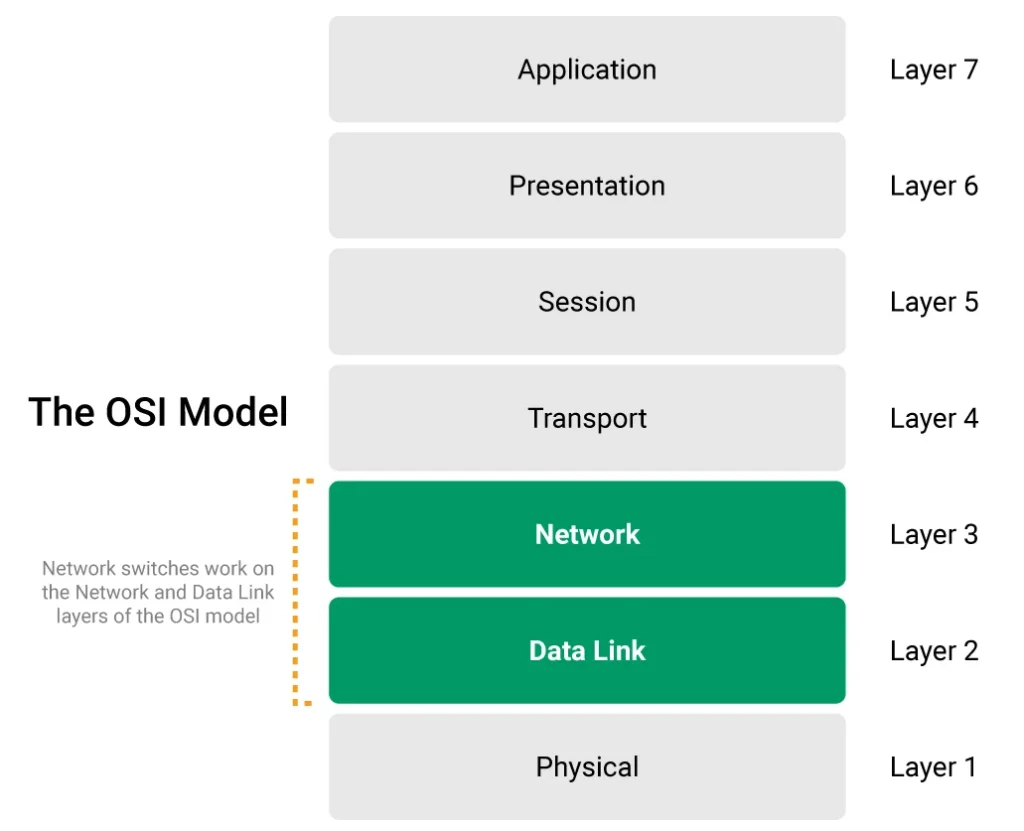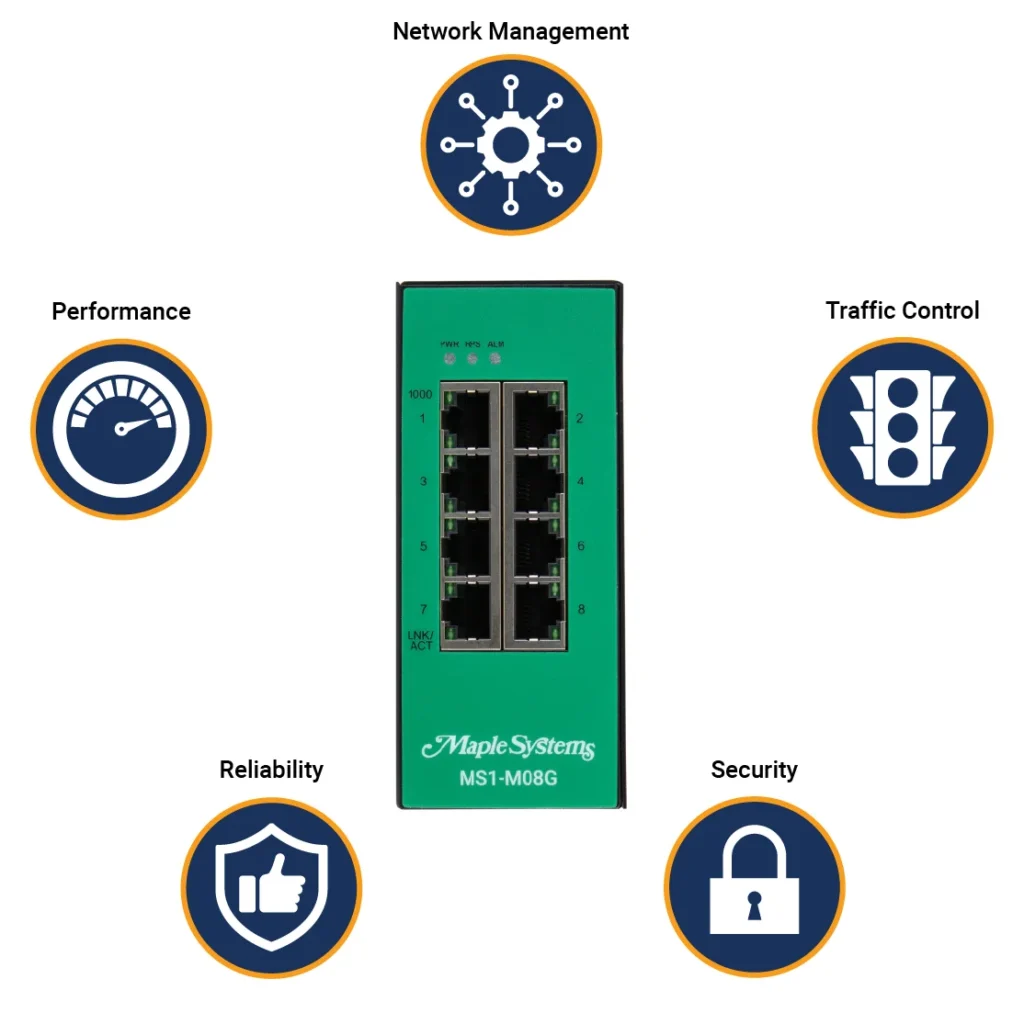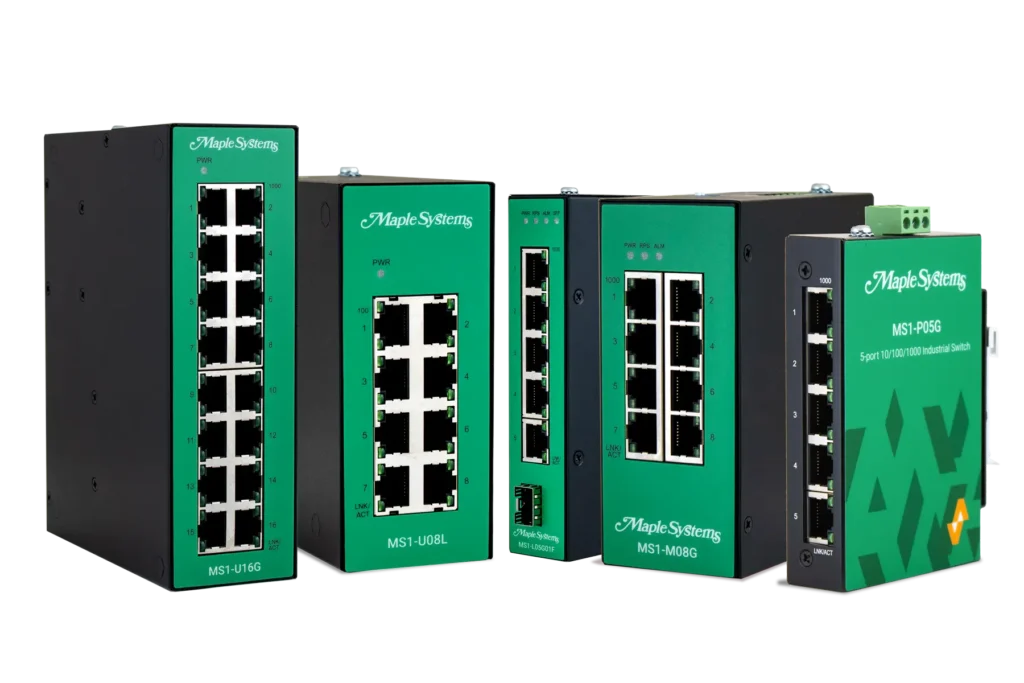Your cart is currently empty!
Networks come in many shapes and sizes. The simplest point-to-point networks connect two nodes with one node as the data sender and one as the data receiver. More complex networks, like automated factories with PLCs, HMIs, and IPCs all running different operations, can connect hundreds of nodes with many senders and receivers.
Simple networks have simple connections. Connecting point-to-point nodes is as easy as cabling the two together—its data can only travel in two ways. But in larger networks where pairs of nodes turn to seas of nodes, data travels many paths. To direct data down those paths and keep traffic from backing up, engineers use network switches.
How does a network switch work?
At their simplest, network switches expand a local area network (LAN) by providing additional Ethernet ports to connect more devices. But a more accurate way to think about modern network switches is as traffic controllers. Rather than performing millions of calculations a second like personal computers, a switch’s job is directing data between hosts within a network. By managing this traffic, network switches allow multiple devices to send and receive data simultaneously.
Most network switches use a device’s media access control (MAC) address, a unique ID attached to every piece of network hardware, to determine where data goes (think of a MAC address like a vehicle’s VIN number). With the network devices’ MAC addresses, the switch creates a MAC address table, also known as a forwarding table. When a device sends data on the network, the switch reads the packet, learns who sent it, and uses the forwarding table to send it to the right port. This process is known as data forwarding.
What is the difference between a network switch and a router?
Network switches only direct data within a network. Routers direct data between networks. Routers also use data forwarding to make sure data gets where it needs to go by directing—or routing—packets from network to network, typically via the internet. Put simply, routers connect your network to other networks, while switches interconnect devices.
Incoming data first arrives at a modem, the device which translates all the digital signals that travel to and from your network and the internet. The modem then sends that data to the router, and the router sends it to a network switch. The network switch then ships it to the device that requested the data. For outgoing data, it travels the same path backwards.

What is a Layer 2 and Layer 3 network switch?
Layer 2 and Layer 3 refer to the different layers of the open systems interconnection (OSI) model, a conceptual framework visualizing network communication. It breaks the process down into seven layers, from physical data transmission to user applications. Data travels up the layers when it’s received and down the layers when it’s sent. Each layer has a specific function and interacts only with the layers directly above and below it.
A Layer 2 network switch works on the second layer of the OSI model, the Data Link layer. Most common networks switches work on Layer 2. At this layer, switches send data based on MAC addresses. A Layer 3 network switch works on the third layer of the OSI model, which is the Network layer. Switches send data based on network device’s MAC and IP addresses at this layer. Some network switches can even send data based on Layer 4.

What is an industrial network switch?
Industrial network switches are tougher than the everyday switch you find at home. The environments these switches work in can be hazardous and unpredictable, and they must withstand whatever is thrown their way. That’s why Maple Systems’ industrial network switches are housed in corrosion resistant, coated aluminum or metal frames backed with IEC certifications and IP ratings for reliable protection against dust, debris, shocks, and vibrations. They’re DIN rail mountable, too, making them easy to add to a control cabinet.
What is an unmanaged network switch?
Unmanaged network switches are the simplest, most common switches used. They are simple plug-and-play devices—there’s no configuration or setup required after plugging it in. For everyday scenarios, like setting up a home network or connecting additional devices without worrying about security, an unmanaged switch will do. While simple, unmanaged network switches can still come with essential quality-of-life features.
For example: Maple Systems’ unmanaged network switches come with link layer discovery protocol (LLDP) filters, flow and storm control, and virtual LAN (VLAN) passthrough. Maple Systems also offers Premium unmanaged network switches with LLDP and VLAN toggles and DIP switch configurations for alarms, filters, and more.
What is a managed network switch?
Managed network switches are more advanced than unmanaged switches, offering greater control, security, and configuration options. Managed switches have varying capabilities, but all have their own IP addresses so that system administrators can access and manage them through the web or a command-line interface (CLI).
Maple Systems has Lite-Managed and Fully Managed network switches. Both offer secure and reliable infrastructure solutions, like simple network management protocol (SNMP) support for monitoring and managing other network devices. Fully Managed network switches also support networking features like link aggregation control protocol (LACP) for combining multiple ports to increase bandwidth and redundancy. Regardless, all managed network switches improve system stability, visibility, and traffic management.

Read What is a managed network switch? for a full breakdown of managed switches and how they’re used.
Learn more with Maple Systems
Need help building a new network or programming your first PLC? Maple Systems has a library of technical and educational resources to help. View our support pages for tutorials, tech notes, sample projects, and more.
Contact us
Contact our sales team for pricing, availability, and support. Email sales@maplesystems.com or call (425) 745-3229.
About the Author

